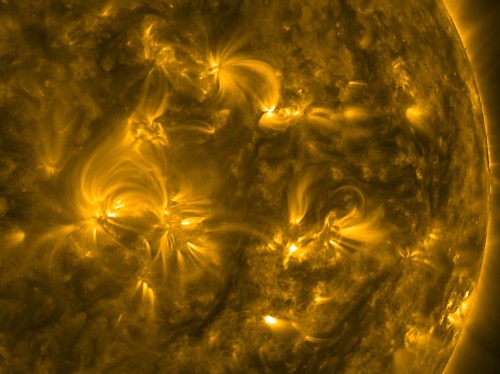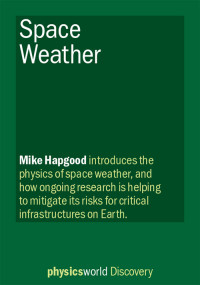By Susan Curtis

Dangerous affair – an extreme ultraviolet image of a tangle of arched magnetic filed lines in the Sun’s corona, taken in January 2016 by NASA’s Solar Dynamics Observatory. (Courtesy: Solar Dynamics Observatory, NASA)
We all love a good disaster movie, but when it comes to real life it’s all too easy to downplay a dangerous but distant threat. Many people choose to live on active volcanoes, the citizens of San Francisco know that “the Big One” could strike at any moment, and yet they believe that the benefits of living in those locations outweigh the risk of a severe event happening in their lifetime.
The same dilemma faces the community of scientists, engineers and policy-makers who are working to understand the impacts of space weather – changes in the Earth’s environment that are largely are driven by physical processes originating from the Sun. Space weather has the potential to disrupt or even damage critical infrastructures on Earth, such as the power grids, aviation routes and communication systems that modern societies depend on, but the last notable event dates back to 2003.
That’s why Mike Hapgood, who heads up the Space Weather Group at RAL Space, part of the UK’s Rutherford Appleton Laboratory, has written a new, free-to-read Physics World Discovery ebook called Space Weather. “I thought it would be a great opportunity to highlight what space weather is really about, and to show how we are linking our scientific knowledge to a better understanding of the impacts on society,” he comments.
 In his book, Hapgood explains how violent eruptions from the solar surface generate huge clouds of magnetized plasma and high-energy particle radiation, which can then propagate across interplanetary space and envelop the Earth. The effects can drive changes in the magnetic fields and atmosphere that surround our planet, even generating electric fields in the surface layers of the Earth that can induce unexpected current surges in power grids.
In his book, Hapgood explains how violent eruptions from the solar surface generate huge clouds of magnetized plasma and high-energy particle radiation, which can then propagate across interplanetary space and envelop the Earth. The effects can drive changes in the magnetic fields and atmosphere that surround our planet, even generating electric fields in the surface layers of the Earth that can induce unexpected current surges in power grids.
“One key challenge in communicating the risk from space weather is that it is not a direct threat to human activities on Earth, but instead a risk to our modern dependence on advanced technologies,” says Hapgood, who plays a key role in advising the UK government on the risks posed by space weather. “Other natural hazards such as strong winds, seismic activity, flooding and even objects falling from space can be directly perceived by human senses, and recognized as an obvious threat to life and property.”
Hapgood explains in his book how good engineering can make crucial infrastructures more resilient to space weather, such as the satellite navigation systems that within about 10 seconds can correct for most of the position errors caused by the effects of solar flares. But he worries that many organizations operating systems at risk have limited experience of the adverse impacts that can be caused by space weather, particularly as there have been no significant events for more than a decade.
“Our personal and organizational experience is generally limited to the past one or two decades, while the insurance industry frequently considers risks at the 1-in-200 year level and operators of some critical systems must consider risks at the 1-in-10,000 year level,” he says. “Only science can provide robust worst-case scenarios over all these timescales by exploiting historical and proxy data together with physics-based simulations.”
You can read Hapgood’s Physics World Discovery ebook free in full at this link.
Guidelines
Show/hide formatting guidelines
this text was deletedwhere people live in harmony with nature and animals</q>
Some text